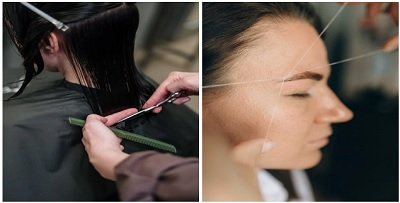The anagen phase is the first stage of the hair life cycle. It is the prolonged phase of the hair growth cycle that lasts for months to years. Cells at the base of the follicle actively divide and multiply during this phase to build up a hair strand.
Hair follicles are the hair-forming factories present under your skin. In the anagen phase, hair growth begins at the base of your hair follicle, i.e. dermal papilla. Cells at the base of hair undergo rapid cell divisions, resulting in the formation of new cells.
Later, these new cells pile up and shift the old cells up the skin surface, forming hair strands or hair shafts. The hair shaft will grow and remain in this phase for a given period of time.
However, the time duration of the anagen phase differs with the type of body hair. That’s why the length of our scalp hair is way longer than the skin hair, eyelashes, eyebrows etc.
Why does cutting hair not hurt but pulling hair does? It’s imperative to note that the hair visible above the skin’s surface, i.e. hair shaft is dead. That’s why we don’t feel any pain when we chop and shave our hair.
But, the hair under your skin is not dead because cells at the base of the hair follicle grow and divide actively. For this reason, we can feel the pain while plucking or pulling up the hair.

In this post, we will discuss the anagen phase in detail, starting from the definition, process, time duration, and factors that affect and favour the anagen phase.
Content: Anagen Phase of Hair Growth
- Anagen Phase
- How to Increase the Anagen Phase of Hair?
- How Long is the Anagen Phase of Hair Growth?
- Conclusion
Anagen Phase
The anagen phase indicates an active growth phase of hair. Let’s dig into the journey of hair growth. First, cells in the hair bulb keep on dividing to produce new cells. Then, new cells will pile up, create room for themselves and push old cells upward to the skin as a hair shaft until the end of this phase. So, the anagen phase is the stage in which the hair shaft is formed and extended.
80 to 90% of our hair remains in this growth phase. A genetic factor is a determining factor for how long your hair would be in the anagen phase. But other factors like poor diet, hair-washing, and age can shorten your anagen phase.
Hair from your scalp grows at a rate of about 1 cm per month. Facial hair, and especially eyelashes, eyebrows and body hair, grow at a slower pace.
What Happens During the Anagen Phase?
The hair follicle, bulb and papilla are the areas under the skin that perform a distinct role. The hair follicle extends underskin as tree root develops underneath the ground.

As the hair follicle is present in the deep layers of the skin, it anchors a single hair strand into the skin. The hair follicle is a sac-like structure that houses the hair bulb and papilla, where all the magic happens.
The hair bulb is the swollen end of the hair, having a layer of mitotically active basal cells. It surrounds the dermal papilla. The hair bulb is the active region where new cells proliferate to form a hair shaft.
The papilla below the hair bulb supplies blood and oxygen necessary for hair growth. It triggers basal cells to start the development of new hair during the anagen phase.
The basal cells divide and multiply every 23 to 72 hours to generate a hair shaft. Tiny blood vessels and capillaries connected to the papilla nourish cells dividing in the hair bulb. Also, they deliver hormones regulating hair growth at different times of life.
New cells keep growing from the base by gradually pushing the old or dead cells upward. Thus, the hair strand is a column of dead keratinized hair cells. So, the anagen phase continues this way, as we discussed.
What Happens Next?
Well, it’s not tricky. We know that new leaves in the tree begin to form in the spring and fall in autumn. In the same way, hair grows in the anagen phase and sheds off in the telogen phase.
Let’s discuss it briefly. Hair grows to a certain length, depending on the time it stays in the anagen phase. Then, a hair strand transits to a catagen phase, leaving the dermal papilla, and the hair root shrinks. Later, in the telogen phase, a hair strand sheds off from the skin due to a lack of blood and nutrient supply.
How to Tell if the Hair is in the Anagen Phase?
The anagen phase is the stage of hair growth, marked by the rapid growth and multiplication of cells at the base of the hair follicle and by lengthening of the hair shaft. So, you can judge your body hair in this phase when you can see the visible growth in the length of your hair.
Hair grows faster during summer than the winter because heat increases the blood circulation in your body. During the late anagen phase, your hair is still attached to the papilla, a tiny protrusion at the base of the hair follicle.
How to Increase the Anagen Phase of Hair?
To keep your hair in the active anagen phase for longer, take care of your scalp by doing the following things:
- Use perfectly formulated hair and scalp care solutions.
- Drink plenty of water.
- Do proper hair oiling and scalp massage.
- Get a daily dose of sunshine.
- Consume a healthy diet.
How Long is the Anagen Phase of Hair Growth?
The anagen phase also determines the length of your hair. There is an expected growth of your hair up to an average length of 1 cm after every 28 days.
Why do some people have long hair and some have short hair?
People with long hair have a long anagen phase, while people with short hair have a short anagen phase. Isn’t that very obvious? Yes, because the hair that remains in the anagen phase for longer will grow longer due to the active growth of cells in the hair follicle.
But, hairs that go into the catagen phase soon don’t get much time to grow longer. For this reason, some people have long hair on their heads, while a few have difficulty growing their hair beyond a certain length.
The period of the anagen phase is different for the scalp, body, pubic or eyebrow hair. Scalp hair stays in 2 to 6 years of the anagen phase, due to which we have long hairs on our heads.
On the other hand, the growth phase is short for the hair on arms, legs, eyelashes and eyebrows for up to 30-45 days, so they can’t get that long.
Conclusion
The hair growth cycle involves three main stages. In the first stage (anagen), cells actively divide, continuously adding to the hair shaft. Once a hair is formed completely, the new cells at the hair root push the club hair upward the skin in the catagen phase. In the last stage (telogen), the old hair rests on the skin’s surface for a while and then sheds off.
Mammals like dogs, cats etc., have seasonal or cyclic hair growth and shedding. But hair development and shedding in humans is random. Factors like genetics, ageing, eating habits, pollution, etc., greatly impact your hair.
Depending upon these factors, some have strong long hair, while some have damaged hair. At any given time, the time duration between each phase of the cycle may vary in humans.

